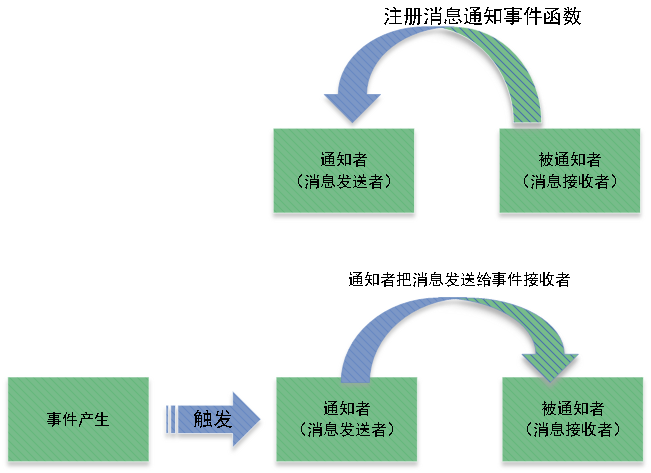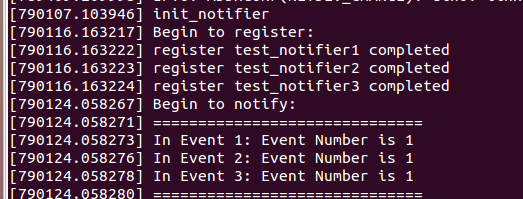概念
大多数内核子系统都是相互独立的,因此某个子系统可能对其它子系统产生的事件感兴趣。为了满足这个需求,也即是让某个子系统在发生某个事件时通知其它的子系统,Linux内核提供了通知链的机制。通知链表只能够在内核的子系统之间使用,而不能够在内核与用户空间之间进行事件的通知。通知链表是一个函数链表,链表上的每一个节点都注册了一个函数。当某个事情发生时,链表上所有节点对应的函数就会被执行。所以对于通知链表来说有一个通知方与一个接收方。在通知这个事件时所运行的函数由被通知方决定,实际上也即是被通知方注册了某个函数,在发生某个事件时这些函数就得到执行。其实和系统调用signal的思想差不多。
代码位置
include/linux/notifier.h kernel/notifier.c 代码不超过 1000 行,但是也是因为代码少,才显现出大神的厉害之处。
数据结构
Linux 内核通知链的操刀大神是 Alan Cox,这个大神也是Linux 协议栈头部的大boss,我猜测当时主要是用来做网络方面的通知需要,比如网络IP发生变化需要通知到其他的子系统等等。像类似的usb插拔等也是用到Linux 内核通知链的。
也就是,你想关心我,就提前给我注册回调函数,我发生情况后,我就告诉你,这就好像你小时候出去玩,出去的时候跟你老妈说,妈妈妈妈,煮好饭的时候要记得叫我哈,你妈煮好饭后就在大门口叫,仔啊,快回家吃饭了。
通知链有四种类型:原子通知链( Atomic notifier chains ):通知链元素的回调函数(当事件发生时要执行的函数)只能在中断上下文中运行,不允许阻塞。
对应的链表头结构:
struct atomic_notifier_head
{ spinlock_t lock; struct notifier_block *head;
};可阻塞通知链( Blocking notifier chains ):通知链元素的回调函数在进程上下文中运行,允许阻塞。
对应的链表头:
struct blocking_notifier_head
{ struct rw_semaphore rwsem; struct notifier_block *head;
};原始通知链( Raw notifier chains ):对通知链元素的回调函数没有任何限制,所有锁和保护机制都由调用者维护。
对应的链表头:
struct raw_notifier_head
{ struct notifier_block *head;
};SRCU 通知链( SRCU notifier chains ):可阻塞通知链的一种变体。
对应的链表头:
struct srcu_notifier_head
{ struct mutex mutex; struct srcu_struct srcu; struct notifier_block *head;
};通知链的核心结构:
struct notifier_block
{ int (*notifier_call)(struct notifier_block *, unsigned long, void *); struct notifier_block *next; int priority;
};其中notifier_call是通知链要执行的函数指针,next用来连接其它的通知结构,priority是这个通知的优先级,同一条链上的notifier_block{}是按优先级排列的。内核代码中一般把通知链命名为xxx_chain, xxx_nofitier_chain这种形式的变量名。
简单的使用说明
 通知链的事件和注册通知链的回调是对应的,当对应的事件产生了,发送者就触发注册通知链的回调函数执行。
通知链的事件和注册通知链的回调是对应的,当对应的事件产生了,发送者就触发注册通知链的回调函数执行。
运作机制
通知链的运作机制包括两个角色:
•被通知者: 对某一事件感兴趣一方。定义了当事件发生时,相应的处理函数,即回调函数。但需要事先将其注册到通知链中(被通知者注册的动作就是在通知链中增加一项)。•通知者: 事件的通知者。当检测到某事件,或者本身产生事件时,通知所有对该事件感兴趣的一方事件发生。他定义了一个通知链,其中保存了每一个被通知者对事件的处理函数(回调函数)。通知这个过程实际上就是遍历通知链中的每一项,然后调用相应的事件处理函数。
包括以下过程:
•通知者定义通知链。•被通知者向通知链中注册回调函数。•当事件发生时,通知者发出通知(执行通知链中所有元素的回调函数)。
被通知者调用 notifier_chain_register 函数注册回调函数,该函数按照优先级将回调函数加入到通知链中:
static int notifier_chain_register(struct notifier_block **nl, struct notifier_block *n)
{ while ((*nl) != NULL) { if (n->priority > (*nl)->priority) break; nl = &((*nl)->next); } n->next = *nl; rcu_assign_pointer(*nl, n); return 0;
}注销回调函数则使用 notifier_chain_unregister 函数,即将回调函数从通知链中删除:
static int notifier_chain_unregister(struct notifier_block **nl, struct notifier_block *n)
{ while ((*nl) != NULL) { if ((*nl) == n) { rcu_assign_pointer(*nl, n->next); return 0; } nl = &((*nl)->next); } return -ENOENT;
}通知者调用 notifier_call_chain 函数通知事件的到达,这个函数会遍历通知链中所有的元素,然后依次调用每一个的回调函数(即完成通知动作):
static int __kprobes notifier_call_chain(struct notifier_block **nl, unsigned long val, void *v, int nr_to_call, int *nr_calls)
{ int ret = NOTIFY_DONE; struct notifier_block *nb, *next_nb; nb = rcu_dereference(*nl); while (nb && nr_to_call) { next_nb = rcu_dereference(nb->next); #ifdef CONFIG_DEBUG_NOTIFIERS if (unlikely(!func_ptr_is_kernel_text(nb->notifier_call))) { WARN(1, "Invalid notifier called!"); nb = next_nb; continue; }
#endif ret = nb->notifier_call(nb, val, v); if (nr_calls) (*nr_calls)++; if ((ret & NOTIFY_STOP_MASK) == NOTIFY_STOP_MASK) break; nb = next_nb; nr_to_call--; } return ret;
}参数nl是通知链的头部,val表示事件类型,v用来指向通知链上的函数执行时需要用到的参数,一般不同的通知链,参数类型也不一样,例如当通知一个网卡被注册时,v就指向net_device结构,nr_to_call表示准备最多通知几个,-1表示整条链都通知,nr_calls非空的话,返回通知了多少个。
每个被执行的notifier_block回调函数的返回值可能取值为以下几个:
•NOTIFY_DONE:表示对相关的事件类型不关心。•NOTIFY_OK:顺利执行。•NOTIFY_BAD:执行有错。•NOTIFY_STOP:停止执行后面的回调函数。•NOTIFY_STOP_MASK:停止执行的掩码。Notifier_call_chain()把最后一个被调用的回调函数的返回值作为它的返回值。
举例应用
在这里,写了一个简单的通知链表的代码。实际上,整个通知链的编写也就两个过程:
首先是定义自己的通知链的头节点,并将要执行的函数注册到自己的通知链中。其次则是由另外的子系统来通知这个链,让其上面注册的函数运行。这里将第一个过程分成了两步来写,第一步是定义了头节点和一些自定义的注册函数(针对该头节点的),第二步则是使用自定义的注册函数注册了一些通知链节点。分别在代码buildchain.c与regchain.c中。发送通知信息的代码为notify.c。
代码1 buildchain.c。它的作用是自定义一个通知链表test_chain,然后再自定义两个函数分别向这个通知链中加入或删除节点,最后再定义一个函数通知这个test_chain链:
#include <asm/uaccess.h>
#include <linux/types.h>
#include <linux/kernel.h>
#include <linux/sched.h>
#include <linux/notifier.h>
#include <linux/init.h>
#include <linux/types.h>
#include <linux/module.h>
MODULE_LICENSE("GPL"); /*
* 定义自己的通知链头结点以及注册和卸载通知链的外包函数
*/ /*
* RAW_NOTIFIER_HEAD是定义一个通知链的头部结点,
* 通过这个头部结点可以找到这个链中的其它所有的notifier_block
*/
static RAW_NOTIFIER_HEAD(test_chain); /*
* 自定义的注册函数,将notifier_block节点加到刚刚定义的test_chain这个链表中来
* raw_notifier_chain_register会调用notifier_chain_register
*/
int register_test_notifier(struct notifier_block *nb)
{ return raw_notifier_chain_register(&test_chain, nb);
}
EXPORT_SYMBOL(register_test_notifier); int unregister_test_notifier(struct notifier_block *nb)
{ return raw_notifier_chain_unregister(&test_chain, nb);
}
EXPORT_SYMBOL(unregister_test_notifier); /*
* 自定义的通知链表的函数,即通知test_chain指向的链表中的所有节点执行相应的函数
*/
int test_notifier_call_chain(unsigned long val, void *v)
{ return raw_notifier_call_chain(&test_chain, val, v);
}
EXPORT_SYMBOL(test_notifier_call_chain); /*
* init and exit
*/
static int __init init_notifier(void)
{ printk("init_notifier\n"); return 0;
} static void __exit exit_notifier(void)
{ printk("exit_notifier\n");
} module_init(init_notifier);
module_exit(exit_notifier);代码2 regchain.c。该代码的作用是将test_notifier1 test_notifier2 test_notifier3这三个节点加到之前定义的test_chain这个通知链表上,同时每个节点都注册了一个函数:
#include <asm/uaccess.h>
#include <linux/types.h>
#include <linux/kernel.h>
#include <linux/sched.h>
#include <linux/notifier.h>
#include <linux/init.h>
#include <linux/types.h>
#include <linux/module.h>
MODULE_LICENSE("GPL"); /*
* 注册通知链
*/
extern int register_test_notifier(struct notifier_block*);
extern int unregister_test_notifier(struct notifier_block*); static int test_event1(struct notifier_block *this, unsigned long event, void *ptr)
{ printk("In Event 1: Event Number is %d\n", event); return 0;
} static int test_event2(struct notifier_block *this, unsigned long event, void *ptr)
{ printk("In Event 2: Event Number is %d\n", event); return 0;
} static int test_event3(struct notifier_block *this, unsigned long event, void *ptr)
{ printk("In Event 3: Event Number is %d\n", event); return 0;
} /*
* 事件1,该节点执行的函数为test_event1
*/
static struct notifier_block test_notifier1 =
{ .notifier_call = test_event1,
}; /*
* 事件2,该节点执行的函数为test_event1
*/
static struct notifier_block test_notifier2 =
{ .notifier_call = test_event2,
}; /*
* 事件3,该节点执行的函数为test_event1
*/
static struct notifier_block test_notifier3 =
{ .notifier_call = test_event3,
}; /*
* 对这些事件进行注册
*/
static int __init reg_notifier(void)
{ int err; printk("Begin to register:\n"); err = register_test_notifier(&test_notifier1); if (err) { printk("register test_notifier1 error\n"); return -1; } printk("register test_notifier1 completed\n"); err = register_test_notifier(&test_notifier2); if (err) { printk("register test_notifier2 error\n"); return -1; } printk("register test_notifier2 completed\n"); err = register_test_notifier(&test_notifier3); if (err) { printk("register test_notifier3 error\n"); return -1; } printk("register test_notifier3 completed\n"); return err;
} /*
* 卸载刚刚注册了的通知链
*/
static void __exit unreg_notifier(void)
{ printk("Begin to unregister\n"); unregister_test_notifier(&test_notifier1); unregister_test_notifier(&test_notifier2); unregister_test_notifier(&test_notifier3); printk("Unregister finished\n");
} module_init(reg_notifier);
module_exit(unreg_notifier);代码3 notify.c。该代码的作用就是向test_chain通知链中发送消息,让链中的函数运行:
#include <asm/uaccess.h>
#include <linux/types.h>
#include <linux/kernel.h>
#include <linux/sched.h>
#include <linux/notifier.h>
#include <linux/init.h>
#include <linux/types.h>
#include <linux/module.h>
MODULE_LICENSE("GPL"); extern int test_notifier_call_chain(unsigned long val, void *v); /*
* 向通知链发送消息以触发注册了的函数
*/
static int __init call_notifier(void)
{ int err; printk("Begin to notify:\n"); /* * 调用自定义的函数,向test_chain链发送消息 */ printk("==============================\n"); err = test_notifier_call_chain(1, NULL); printk("==============================\n"); if (err) printk("notifier_call_chain error\n"); return err;
} static void __exit uncall_notifier(void)
{ printk("End notify\n");
} module_init(call_notifier);
module_exit(uncall_notifier);Makefile文件:
ifneq ($(KERNELRELEASE),)
EXTRA_CFLAGS = -Wall -g
obj-m := buildchain.o regchain.o notify.o
else
PWD := $(shell pwd)
KVER := $(shell uname -r)
KDIR := /lib/modules/$(KVER)/build
all: $(MAKE) -C $(KDIR) M=$(PWD) modules
clean: rm -rf .*.cmd *.o *.mod.c *.ko .tmp_versions
endif 执行结果:

扫码或长按关注
回复「 加群 」进入技术群聊






)


)




:类的继承)
)



